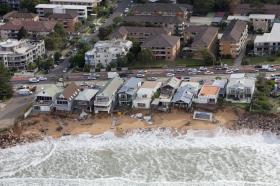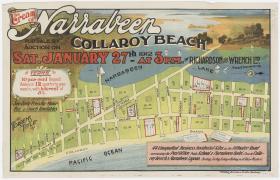Collaroy case study
Learning intention
Students are learning to:
- identify the nature, impacts and causes of atmospheric and hydrological hazards
- understand how human interaction with the environment can change the landscape and exacerbate the impacts of natural hazards
- use photographic and written sources to complete a case study of a specific atmospheric and hydrological event.
Success criteria
Students will be successful when they can:
- communicate geographical information about the nature, impact and cause hydrological and atmospheric events
- think critically about the management of coastal environments
- explain how interactions and connections between people, places and environments can influence the impact of natural hazards.
Student Activities
The case of the missing beach
Students use a series of photographs as geographical sources to understand the nature of an atmospheric and hydrological event on the east coast of NSW.

Managing the coastal environment
Students investigate the interrelationship of human and environmental factors which make some places vulnerable.

NSW Syllabus for the Australian Curriculum Geography K-10
- GE4–1: Locates and describes the diverse features and characteristics of a range of places and environments.
- GE4–2: Describes processes and influences that form and transform places and environments.
- GE4–3: Explains how interactions and connections between people, places and environments result in change.
- GE4–5: Discusses management of places and environments for their sustainability.
- GE4–7: Acquires and processes geographical information by selecting and using geographical tools for inquiry
- GE4–8: Communicates geographical information using a variety of strategies.
Students:
Investigate ONE contemporary atmospheric hazard or hydrologic hazard including causes, impacts and responses, for example: (ACHGK042)
- explanation of the spatial distribution, cause and impact of the disaster
- examination of responses by individuals, groups and government to the impact of the disaster
- discussion of management strategies to reduce the future impact of similar hazard events
The environmental characteristics of a place are influenced by human actions and the actions of environmental processes over short to long time periods.
The sustainability of places may be threatened by a range of factors, for example, natural hazards; climate change; economic, social and technological change; government decisions; conflict; exhaustion of a resource and environmental degradation.
Each type of environment has its specific hazards. The impact of these hazards on people is determined by both natural and human factors, and can be managed but not eliminated by prevention, mitigation and preparedness.
- Civics and citizenship
- Critical and creative thinking
Background information for teachers and students
On 5 June 2016, a violent storm bringing torrential rain and gale force winds struck the east coast of NSW, fanned by a vast East Coast low. This East Coast Low and the resulting storm, combined with the Winter Solstice Spring Tide (‘king tide’) to create a unique weather event, which caused widespread damage and destruction along the coastline.
One of the heaviest hit locations was a small section of Collaroy Beach where 10 properties between Stuart and Ramsay Street had to be evacuated as the wild weather caused entire backyards, verandas and even a swimming pool to be swept away.
This stretch of residential property had been damaged by wild weather before and has been an ongoing problem since the land was subdivided and sold for private development between 1910 and 1915. Collaroy Beach residences are vulnerable as the housing is built on the active beach and foredunes.
There is ongoing debate about the best way to prevent further damage. Building a seawall has been proposed as a solution — but that is problematic because a permanent seawall would cause the sand from Collaroy Beach to recede, and eventually the much-loved beach would disappear, never to return.
The situation at Collaroy Beach can be used to inform developers and local councils on how best to proceed when land subdivision and new buildings are planned for coastal areas to avoid this kind of damage and destruction to property.